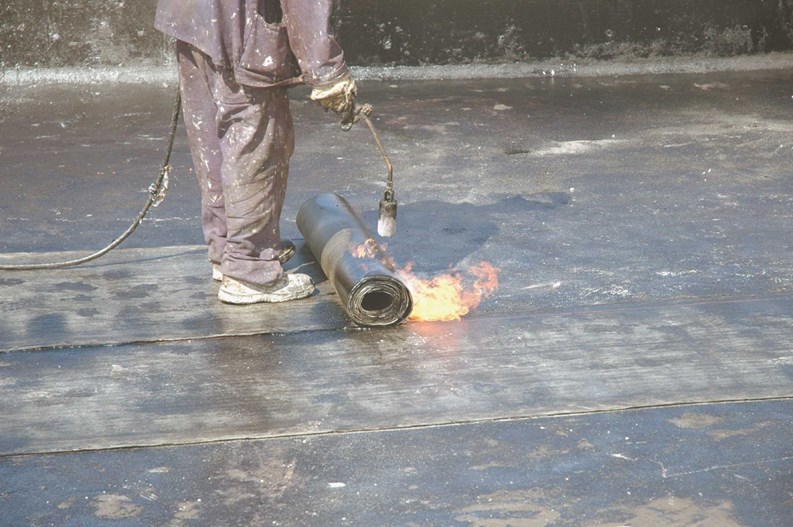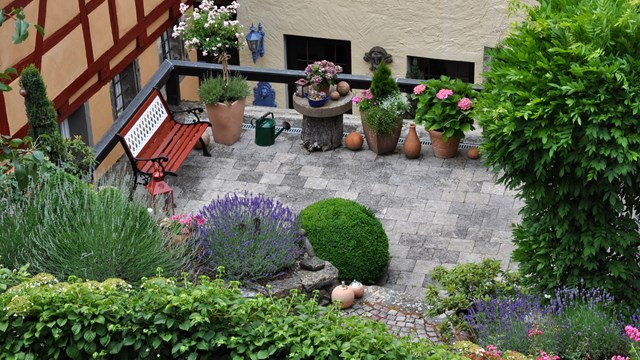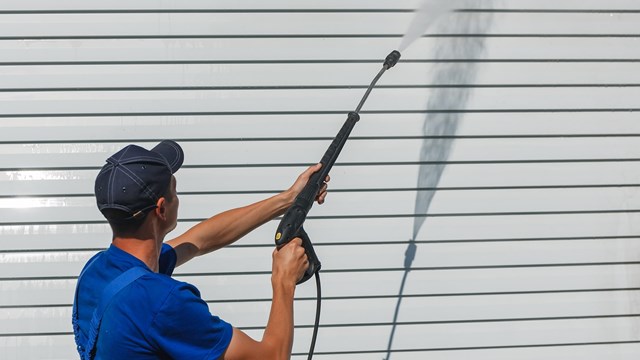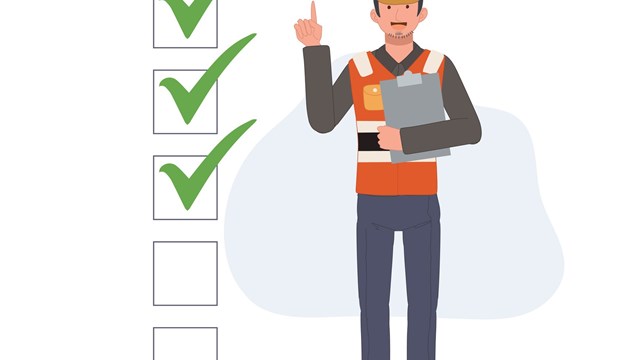After the four walls of a given structure, the roof is sometimes referred to as the “fifth plane”—and just like the walls that hold it up, the roof is an all-important structure that can make or break a building’s performance. Chicagoland's changeable climate, which as we all know ranges from sweltering hot and humid summer heat to bone-chilling cold in the winter months, often exacerbates trouble spots. If not properly maintained, even a minor roof problem can lead to costly repairs.
What's Up There?
Tyler Amick, director of repair and special services for Sullivan Roofing in Schaumburg says the modified bitumen is the most common type of roof in Chicago. The modified bitumen, he says, comes in a 3-foot wide by 100-foot long roll of roofing material, which makes for a challenging installation.
Reid Robinson, a property preservation consultant with Weathershield, LLC in Oswego agrees with Amick. “Modified bitumen is likely the most common material used for flat roofing applications in Chicago,” says Robinson. “You will see quite a few built up roofs here and there but for your taller buildings, it is a logistical nightmare getting hot tar or a kettle on the roof to do an application. Depending on the contractor, more recent additions to the marketplace are showing up—but these types of roofs are expensive, manufacturer specific and in most cases have a much shorter history to look at in determining the life expectancy of the product.”
According to experts, the modified bitumen is an evolution of asphalt roofing. It’s made from asphalt and a variety of modifiers and solvents. There are several ways of connecting pieces of this material. In a heat application process the seams are heated to melt the asphalt together and create a seal. There is also a cold applied adhesive application process, and some self-adhesive forms of this system. This material is also referred to as APP or SBS.
“In the suburbs of Chicago the most common type of roof on larger square-foot buildings is EPDM [Ethylene Propylene Diene Monomer] because of cost and larger rolls equals faster installation,” says Amick. “However, with the green movement, more people are looking into a white roof. The City of Chicago has a reflective requirement which requires a white membrane or a roof material to be coated to meet the reflectivity requirement. In many of the suburbs it’s the owners’ choice to have a white or black roof; however economics might play more of a role. The bitter taste of poor quality lingers far longer than the initial sweetness of a cheap price.”
Jason Burns, director of sales for Windward Roofing & Construction in Chicago says, “Flat roofs are very common in the city of Chicago but the residential suburban areas have more steep pitched shingle type roofs. Today’s roofing technology in both flat and shingle roof styles have advanced capabilities and designs to handle the harshest of weather conditions,” adds Burns.
Common Problems
Even though a majority of roofs might be flat throughout Chicago they are constructed by different companies, which results in varied states of performance so it’s best to do your homework and always check references while searching for a roofing company.
Industry experts agree that there are leading problems with almost every flat roof that usually occur around the drains, pitch boxes, flashing and electrical piping. Regular maintenance and oversight can prevent massive and costly roof problems from occurring.
“We see a lot of issues and roof problems caused by a lack of maintenance and routine care,” says Burns. “Most people unfortunately do not think about their roof until it becomes a problem.”
“The biggest issue with most roofs is lack of maintenance,” says Robinson. “Most people and organizations don’t worry about their roofs until there is a leak. A close relationship with a qualified contractor who can inspect your roof for possible damage or weak points in the system is your best bet against costly repairs. The best way to maintain a roof is periodic inspections by an Illinois State Licensed Roofer or qualified consultant. Inaction and deferment of maintenance will always lead to leaks and maintenance issues in the future. All it takes is one season’s freeze-thaw cycle to make a small repair a major problem. Sometimes an ounce of caulk can prevent a pound of paperwork.”
“Simple routine inspections and maintenance to clean gutters and drains, check flashings, skylights and protrusions will save building owners and residents a lot of future headaches,” adds Burns.
Cost & New Technologies
Many elements come into play during the construction of a roof. “In the past, flat roofing mostly consisted of dragging a kettle of hot tar around and assembling a ‘built up roof system,” says Burns. “With today’s technology, much cleaner, greener and reliable roofing membranes are available. I would say the majority of today’s flat roofing systems are composed of single ply roofing membranes such as TPO, EPDM, and PVC which offer great protection against Chicago’s extreme weather conditions and come with great warranties between 10 and 30 years.”
“Most construction related to roofing starts about the given roof deck (wood, metal, Gypsum, Tectum or concrete),” says Amick. “Historically, the roofer will add roof insulation over the deck and then install the roof system per the manufacturer’s warranty requirement or architect specification.”
Burns notes that the state of Illinois and the city of Chicago have recently adopted and enforced an Energy Conservation Code that applies to roofing construction. The codes include implementing the use of roofing insulations and reflective roofing membranes and coatings to lessen the impact of heat and solar reflectivity on the earth and ozone layer.
Experts say that depending on a host of variables such as weather, materials, size and maintenance, a new roof can last anywhere from 15 to 25 years. While most roofing companies will do an inspection and assessment as part of their proposal, those companies that do charge for a report charge from $0.07 to $0.20 a square foot, depending on the size of the roof.
“A lot of factors result in the cost of a roof,” says Amick. “For example, a low sloped 10,000-square-foot building in the suburbs might cost $5.00 to $8.00 a square foot as compared to a building with limited access, that could be $15.00 to $20.00 a square foot. What type of roof, how much R-value, does it need tapered insulation and how long of a warranty you want are all factors. Any reputable roofing company will provide free roof evaluations and budgets to help the client make an informed selection.”
“There’s an extremely wide variance when it comes to how much a roof should cost,” adds Burns. “On shingle roofs, the average is anywhere between $3.00 and $5.50 per square foot depending on the building access, design and roof system needs. High-rise flat roof replacements typically range anywhere from $10.00 to $25.00 per square foot. Living green roof assemblies with plant life, gardens and walkway pavers can go up to $120.00 per square foot.”
Preventative Maintenance
When it comes to upkeep, Amick says Chicago’s weather does play a factor on any roof type but with a proper preventative maintenance program small issues can be caught before they become costly repairs. He recommends performing inspections at least twice a year. “Inspections are typically conducted during the spring after a harsh winter and in the fall before the harsh winter starts,” says Amick. “Some roof manufacturers even require documented roof maintenance programs as part of their roof system warranty.”
Amick believes that an owner should always request a “no dollar limit warranty.” They can be 10, 15, 20 or 30 years from the manufacturer of the roofing material. The NDL warranty will require that the manufacturer of the roofing material has inspected and certified that the roof was installed to the best of their ability per the required specifications.
“If you want to protect and maintain your roof it’s important to sign up with a competent, licensed roofing company for an annual roof maintenance program” adds Burns. “The relatively small initial cost can save thousands of dollars down the road.”
In the end, experts agree that hiring a company to do continual oversight is the best option for boards and managers. It’s also wise to have a reputable company come in once a month to do maintenance and periodic inspections. This type of membrane maintenance will save tons of money down the line because you might discover a moisture issue before it escalates to a serious problem.
With good installation, proper care, and regular maintenance, your building's roof should keep the rain, and everything else, for that matter, off your heads for many, many years to come.
W.B. King is a freelance writer and a frequent contributor to The Chicagoland Cooperator. Staff Writer Christy Smith-Sloman contributed to this article.







Leave a Comment